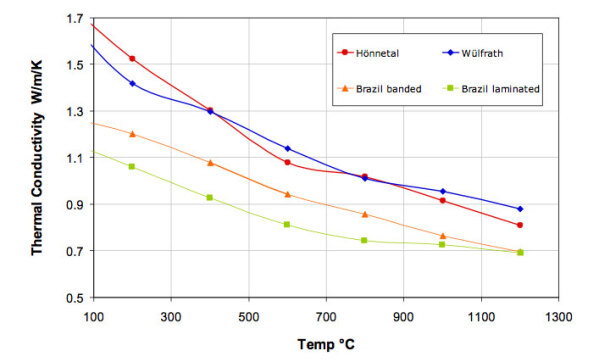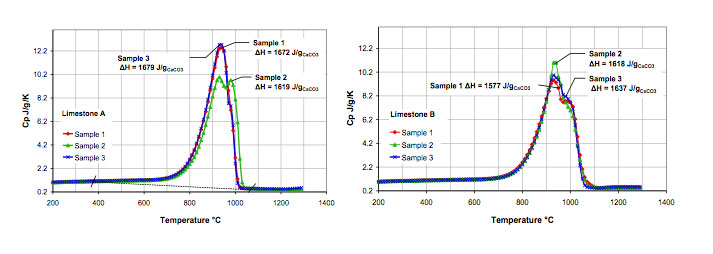Messung thermophysikalischer Stoffwerte bis 1600°C
Die thermophysikalischen Stoffwerte Wärmeleitfähigkeit, spezifische Wärmekapazität, thermische Ausdehnung (Dichteänderung), Phasenumwandlungsenthalpien und Phasenumwandlungs-, Zersetzungstemperatur werden bis zu Temperaturen von 1600 °C, jedoch höchsten bis zur Schmelztemperatur gemessen.
Zur Ermittlung der Wärmeleitfähigkeit werden dünne Scheiben des zu untersuchenden Materials von der Unterseite mit einem Laserimpuls beschossen. Die anschließende Temperaturerhöhung auf der Oberseite wird mit einer Infrarotkamera hochaufgelöst gemessen. Hieraus kann auf Grund der eindimensionalen Wärmeleitung der Temperaturleitkoeffizient berechnet werden. Die Proben können bei verschiedenen Temperaturniveaus und Gasatmosphären mehrmals beschossen werden.
Die spezifische Wärmekapazität und Dichte werden temperaturabhängig in eigenen Geräten gemessen. (siehe Thermoanalytisches Labor)


Ausgewählte Publikationen zum Forschungsschwerpunkt
- Gierl, C.; Danninger, H.; Silva Gonzalez, M.; Schmidt, J.; Specht, E.: Thermophysical properties of sintered steels - effect of porosity and composition. Vortrag: PM2010 Powder Metallurgy World Congress & Exhibition, Florence; 10.10.2010 - 14.10.2010; in: Proceedings PM2010 Volume 5, European Powder Metallurgy Association, Shrewsbury (2010), ISBN: 9781899072149; 41-5
- Danninger, H.; Gierl, C.; Silva Gonzalez, M.; Schmidt, J.; Specht, E.: Thermal expansion and thermal conductivity of sintered steels - the real effect of the porosity. Vortrag: PowderMet 2010, Ft. Lauderdale FL; 27.06.2010 - 30.06.2010; in: Preprints, Metal Powder Industries Federation, Princeton NJ (2010), 11 S. ISBN: 978-0-9819496-4-2
- Silva, M.; Specht, E.; Schmidt, J.: Thermophysical properties of limestone as a function of origin. Part 2: Calcination enthalpy and equilibrium temperature. Cement Lime Gypsum Int. (2010) No 6, 51-57.
- Silva, M.; Specht, E.; Schmidt, J.: Thermophysical properties of limestone as a function of origin. Part 1: specific heat capacities. Cement Lime Gypsum No 2 (2010) 55-62.
- Silva, M.; Specht, E.; Schmidt, J.; Al-Karawi, J.: Influence of the origin of limestone on its decomposition temperature and on the specific heat capacity and conductivity of lime. Hight Temperature-High Pressure 38 (2010), 361-378.
- Silva, M.; Specht, E.; Schmidt, J., Bauer W.: Comparative evaluation of the thermal conductivity for selected materials measured with a laser flash apparatus and other techniques. Proceedings of 30th International Thermal Conductivity Conference and 18th International Thermal Expansion Symposium, August 29- September 2, 2009, Pittsburgh, USA, 480-488. (ISBN 978-1-60595-015-0)
- Silva, M.; Specht, E.; Schmidt, J.: Importance of the origin of limestone on the thermophysical properties influencing the calcination process. Proceedings of 30th International Thermal Conductivity Conference and 18th International Thermal Expansion Symposium, August 29- September 2, 2009, Pittsburgh, USA, 496-505. (ISBN 978-1-60595-015-0)
- Silva, M.; Specht, E.; Schmidt, J.; Al-Karawi, J.: Influence of the sintering compression of metallurgic powder steel on the thermal properties up to 1000 °C. 30th International Thermal Conductivity Conference and 18th International Thermal Expansion Symposium, August 29- September 2, 2009, Pittsburgh, USA.